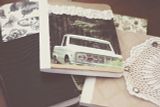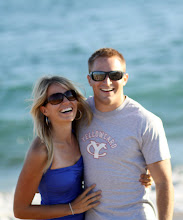Munich is home to a lot of history over the last few centuries and was especially significant during World War II. The concentration camp Dachau is actually right outside the city, but we thought it might be a little heavy for our honeymoon so we saved it for another trip. I'm fascinated by history, though, and couldn't entirely pass up the opportunity to learn more about World War II in the birthplace of the Third Reich.
Thus, Matt and I decided to take a walking tour of the city that focused on the beginning of the Nazi movement. It was incredibly interesting, to say the least. I think I learned more during that three-hour tour than I did in whole semesters spent studying and reading books on the subject. Let me know if you'd like a mini discourse on Hitler, k? For this post, though, I'll just share a few highlights of the tour.
Below is the Hofbrauhaus, where Hitler delivered his first major public speech. Leave it to 2,000 drunk men crammed into a room that should only fit 500 to decide that taking over the world sounds like a good idea. (Not actually what the speech was on, obviously, but you get what I'm saying, right?)
This is our tour guide with the Odeonsplatz in the background. He's standing where the Beer Hall Putsch ended. Once Hitler was in power, he placed a plaque on the wall behind our tour guide, dedicated to the sixteen Nazi's who lost their lives during the Putsch. Those who passed the "shrine" were required by law to give the Nazi salute or else face imprisonment. On the right, you'll see an alleyway between the two buildings--"Dodger's Alley." Those who didn't support the Nazi's learned to dodge the shrine altogether by taking this alley as an alternate route to the Odeonsplatz.
Meanwhile, the Odeonsplatz history dates back much further than Hitler's regime and is surrounded by beautiful buildings. The Felderrnhalle, which was built in the early 1800's, and the Theatinerkirche, a church which was built in the early 1600's.
In front of the Bavarian State Chancellery is a tomb-like war memorial built to honor the Bavarian soldiers lost in the first world war. (And later added upon to honor those who died in WW2 as well). The inscription visible just above the shrubs reads, translated: "They will be resurrected."
The Chancellery is right next to the Hofgarten, a beautiful formal court garden built in 1613. (The spires in the background are the Theatinerkirche.)
The original Nazi Headquarters were in Munich, centered around the Konigsplatz. Hitler's own offices were in this building, called the Fuhrerbrau. Now, the Fuhrerbrau and the other remaining Nazi buildings are part of a university.
This picture is of Hitler and Mussolini on the steps of the Fuhrerbrau after the Munich Conference in 1938. Kind of eerie, isn't it?
This is what the Konigsplatz looked like while the Third Reich was in power... And what it looks like now. The temples (built to honor those first 16 Nazi's who were killed in the Putsch) were destroyed by bombs, and the granite slabs were torn up and replaced by grass:
After the tour, we stopped the first lady that walked by and asked her to take a picture for us with Maximillian in the background. She had something in her hand, but quickly grabbed the camera and snapped the shot. When I took my camera back, she showed us what was in her hands--a dead bird. Which meant I now had dead bird germs on my camera and consequently my hands as well. Great. The lady kept rambling to Matt in German about how she'd seen this bird fall from some height, picked it up off the street, and wasn't able to revive it. PETA would love her. My now-germy hands sure didn't.
Anyway, after using an entire bottle of antibacterial hand sanitizer, we moved on to the Marienplatz for lunch at the old Rathaus (town hall).
Isn't it gorgeous? There's a restaurant inside the courtyard, called the Ratskeller. Missionary Matt planned on taking his wife there someday, so my post-mission Matt followed through. And what can I say? The man has great taste!
On our last day in Munich (yeah... I'm combining posts like that), we finally stopped by Matt's favorite bakery in all of Europe, Hoflinger. We bought some yummy goodness and ate it as we took a final walk through the city. These city gates were built in the middle ages, around 1200 A.D. Isn't that crazy?
For us, it served as a gateway to some last-minute shopping we did around the Marienplatz. We had to go back to see the Glockenspeil in action before catching our train!
And with that, we said Auf Weidersehen to Munich and headed off to Vienna, Austria! And then to Hallstatt, Venice, Rome, Florence and Paris. But we'll get to those later :-)
PS-I'll try to go lighter on the Europe posts from now on so I can get to the rest of it a bit faster. Believe it or not, I'm leaving a lot out already!












































































































